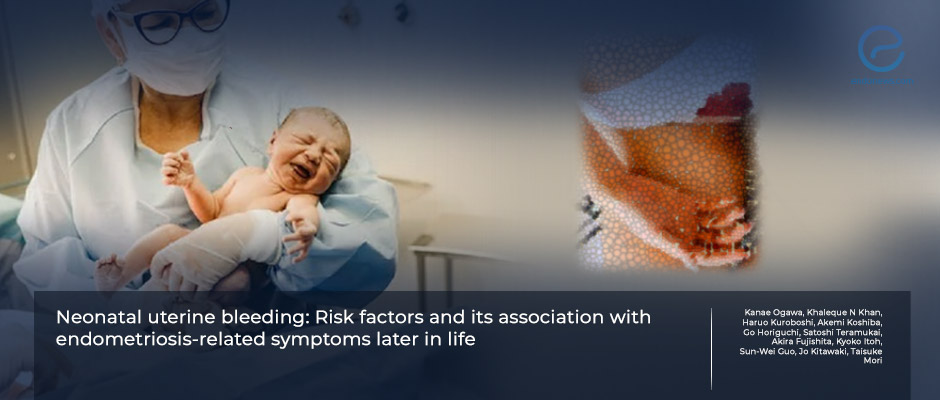Neonatal uterine bleeding at birth and endometriosis later in life
Feb 21, 2024
The babies of the younger mothers seem to have more neonatal uterine bleeding.
Key Points
Importance
- Preeclampsia, low birth weight, post-maturity and dysmaturity, and fetomaternal blood incompatibility have been reported as the risk factors for the occurrence of neonatal uterine bleeding.
Highlights
- The study confirmed the longer gestational age and younger mother age as a high-risk factor for the occurrence of neonatal uterine bleeding.
- The endometriosis-related symptoms in later life in women who had neonatal uterine bleeding seem relevant but need more confirmation.
What's done here:
- The study aimed to investigate the possible association between the history of neonatal uterine bleeding at birth and endometriosis-related symptoms later in life for young women at present.
- A two-part study was set up in some Japanese university hospitals and one of China's hospitals' obstetrics and gynecology departments.
- The first part of the study was a retrospective observational cohort lasting between two different periods.
- The second part was a prospective, cross-sectional, web-based questionnaire survey among young women born between 1996 and 2000 with a history of with or without neonatal uterine bleeding to get information about their endometriosis symptoms.
Key Results:
- The prevalence of neonatal uterine bleeding during the 2013-2017 and 1996-2000 time intervals was retrospectively 9,6% and 3,15%.
- Multiple logistic regression analyses showed the occurrence of neonatal uterine bleeding was associated with the mothers' younger ages and gestational ages longer than 39 weeks.
- Especially in the 2013-1017 time interval, the distinctive feature associated with neonatal uterine bleeding was younger mother age, while increased newborn birth weight and neonatal uterine bleeding were prominent during 1996-2000.
- Having severe cyclic/acyclic pelvic pain was similar between with or without neonatal uterine bleeding women.
Limitations:
- The women in their questionnaire survey group do not have any confirmed diagnosis of endometriosis.
- A larger sample size is needed to be sure of the results of the study.
Lay Summary
In the first few days after birth, some female newborns bleed from the vaginal route, and this is called newborn uterine bleeding. The overt and occult neonatal uterine bleeding prevalence rates are 3-5% and 25-60% retrospectively. The causative risk factors for this condition have been studied previously. The physiopathologic mechanism is similar to the adult endometrium, which is affected by circulating progesterone levels. Maternal progesterone levels caused decidual changes in developing fetal endometrium, and due to a rapid fall in progesterone levels after birth, neonatal uterine bleeding occurred.
The hypothesis that neonatal uterine bleeding can cause endometriosis in the future of those female babies is based on the possibility of settlement of decidual cells in the peritoneum by retrograde flow during the bleeding after birth and awakened by menarche.
To investigate this hypothesis, Ogawa et al. from the Department of Obstetrics and Gynecology of the Kyoto Prefectural University of Medicine, Japan, planned a retrospective study comparing women with or without neonatal uterine bleeding history and another prospective survey by web-based questionnaire to explore endometriosis-like symptoms in young women with a history of neonatal uterine bleeding.
Statistical results indicated the women with a history of neonatal uterine bleeding had significantly younger mothers, and their gestational ages were significantly longer than the women without neonatal uterine bleeding.
In the second part of the research, by the web-based questionnaire, women were asked about their birth weight, menstrual characteristics, cyclic and acyclic pelvic pain, the relation between pain and daily activity, and taking a painkiller. Eight questions of this questionnaire were statistically evaluated between two groups, and multiple regression analyses were made on six different outcomes.
"Although it is currently difficult to show neonatal uterine bleeding is associated with further development of endometriosis, future prospective, cross-sectional studies including patients who have clinical, and ultrasonographic examination with pathologic confirmation of endometriosis will help to make a clear decision about the issue." was the conclusion of the authors. This interesting study was recently published in the European Journal of Obstetrics and Gynecology and Reproductive Biology.
Research Source: https://pubmed.ncbi.nlm.nih.gov/38199071/
prevalence neonatal uterine bleeding risk factors web-based questionnaire survey younger maternal age deep endometriosis.

